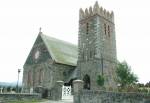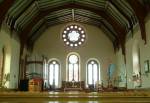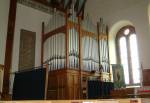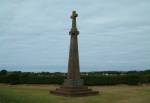Tuesday, April 15, 2025
|
You are here: Isle of Man > Attractions > Early Historical Sites > Stone Crosses HistoryKirk Andreas church is located in St Andrew. Built in 1802 from Sulby Glen stone. A bell tower was added to the main building in 1869. There are eleven crosses held within the church dating from the 7th to 11th centuries.LocationThe village of Andreas can be found in the north of the island.Map Ref: SC 415 993 By Vehicle: Drive to the north of the Island and into the village of Andreas. There are many roads to choose from. The church lies in a corner with two entrances from the road. One from the village centre and the other from the A9. By Bus: The village of Andreas is serviced by bus routes no. 17, 17A, 18, 18A, 20, and 20A from Ramsey. Ramsey is serviced by Douglas, Laxey, and Peel by bus routes no. 3, 3A, 3B, 3C, X3, 5, 5A, 6, 6A, and X5. By Railway: Take the Steam railway to Douglas. Take the Electric Railway to Ramsey. From Ramsey the bus routes no. 17, 17A, 18, 18A, 20, and 20A will have to be taken in order to get up to Andreas. The Site
A churchyard boulder, which has a linear plain Latin cross on each side. No. 37 A Knock y Doonee boulder with a plain cross on one side with the limbs opening ends connected by a ring which is broken by short lines. No. 60 The broken head of a slab with the remains of a Celtic cross on both sides. The cross has a small ring in the centre and a boarding line outlining the cross. The limbs are cut at an angle with curved recesses at their junction marked by shallow depressions and a boarding line. Gaut's Cross (No. 99) A large, badly worn slab with a shafted cross and circle on both sides. This cross is often compare with Kirk Michael 101, which also bears the name of Gaut. The shaft on each side is decorated with plait of five and the spaces at the sides have key fret, twist and ring design, plain twist and a form of linked twist. The inscription up one edge is partly broken away. It reads: ... thana, if (t) Ufaik, fauthur,, sin, in, Kautr, karthi, sunr, Biarnar, fra, Kuli. Translated as (A.B. erected) this (cross) to the memory of Ofeig his father. But Gaut son of Bjorn of Cooiley (Coll) made it. Gaut was the first Norse sculptors in the Isle of Man. Believed to be the son of a Hebridean Norseman from the Island of Coll. No. 109 A fragment with the lower end of each side showing the shaft of a cross. On one side is a ring chain design ending in irregular loops, the space to the right has key fret. The other side has plait and a form of link twist like that on Kirk Michael 101. No. 111 A fragment of a Norse cross with a tendril pattern and key fret on one side and a twist and ring and link twist with remains of an inscription in Bind runes (Where each character representing two or more runes.) on the other side. The inscription has not yet been deciphered. No. 113 A small slab broken down its length. On each side is a long shafted cross without a circle. It is possible to make out a ring chain pattern and plait on one side and the outline of the cross on the other. The inscription on edge reads: r)aisti, krus, thaana, afti(r. meaning (A.B.) erected this cross to the memory of (C.D.). Siguard's Cross - Fafni's Bane (No. 121) Believe to date from the late tenth century. The top part of the cross is broken off. Each side shows the shaft of a cross with a broad flat circle. The decorative treatment is free from Celtic influence and consists of zoomorphic interlacement and figure subjects. One side is decorated with the hero Sigurd and the dragon Fafni. Below is a figure of Sigurd piercing the dragon with his sword; above the hero is seen stooping over a fire roasting the heart of his foe, he cools his scalded fingers in his mouth, this action allows him to understood the language of birds and learn from them the treachery of the dwarf Regin, one of the birds is seen at his back, while above stands his steed Grani, the grey one. The other side shows serpent headed interlacing, a mangled figure attacked by one of the serpents, illustrating a later part of the story, when Gunnar, who had become possessed of the treasure is thrown into the snake pit. This cross is one of the four Sigurd crosses found on the Isle of Man. The others are at Jurby, Malew and Maughold. They depict scenes from the popular Norse folk tale. The story starts by Loki throwing a stone to kill Otter as he was wanting a salmon. For this sin the gods had to pay a great treasure, the possession of which carried a curse. The treasure passed to the dragon Fafnir. Odin told the hero Sigurd to dig a pit and lie in it to wait for the dragon. The scene of Sigurd in pit driving his sword into the dragon is most clearly shown on a cross at Jurby and also on the part of the cross at Andreas. Odin then told Sigurd to cut out and roast the dragon's heart. When feeling the heart Sigurd burned his finger and on sucking it he tasted the dragon's blood, which enabled him to understand the song of birds, who told him of danger from enemies. The Andreas cross clearly shows Sigurd roasting the heart over the fire and sucking his finger. His ear is turned to hear the bird, while his horse looks on over his shoulder. The story goes on to tell how the treasure passed to Sigurd's foster brother Gunnar, but the curse continued with the treasure and Gunnar eventually was cast bound into a pit of serpents. Thorwald's Cross-Slab (No. 128) A fragment of a cross without a circle showing Odin and the Fenris Wolf. The shaft is decorated with ring chain with the ring extended in two out curving horns. On one side a scene from Ragnarok, when the gods and the heros go forth to that last battle with all the forces of evil. Odin, plunges his spear into the breast of the Fenis Wolf, who seizes him in its jaws, afterwards comes Vidar the silent, son of Odin. The artist has done a closing scene of Northern Heathendom on one side and on the other the coming of Christ. There is a missionary figured, holding in one hand a cross, in the other a copy of the Gospel. The fish in front is the well known Christian symbol, the knotted serpents witness the triumph of Christ over the Devil with the treading on adders or bruising the serpent's head. There are the remains of an inscription reading: Thyryaltr, raisti krus, tho. translated as Thorwald raised this cross ... Sandulf's Cross-Slab (No. 131) A 10th century, Norse cross slab with a shafted cross without a circle on each side. One side has a plait of five on the shaft and s interlacing ring at the top with narrow borders of step pattern and key fret. Above the head is a horizontal band in plait of four, on the shaft is another hand bordered and decorated with twist and ring. Above each arm is figured a bird. The spaces at the sides of the cross show various beasts, a hart pursued by a hound, a hunter on horseback armed with a club, and a boar, on the right a goat, a wolf, a hind and bear, with a running hound at the back of the wolf. The other side has ring chain on the shaft like that on Thorwald's cross, a small cross with a spiral projection from the ring at either side. Above the head is a design of two triquetras back to back with a central loop. At the side of the shaft are breasts, a stag follow by a knotted serpent, an ox and a boar. Below the cross is a robed figure on horseback, one hand on the reins, the saddle is visible at the front and at the back of the rider below the cross is an incised figure of a wolf. This wolf maybe a play on the name Sand wolf, who set up this monument in memory of his wife, Arinbjorg here represented seated on her horse. The inscription up one side reads: Sont, Ulf, hin, Suarti, raisti, krus, thona, aftir, Arin, Biaurk, kuinu, sina. Sandulf the black raised this cross to the memory of Arinbjorg his wife. (This is a rare instance, where a woman with a Scandinavian name is recorded in Manx Runic (Celtic) inscription. No. 168 Part of a large Norse style cross slab, weathered but with traces of a cross shaft with paired volutes at bottom. |
    |
|
Other Guides by Maxima Systems Ltd: Disney World
